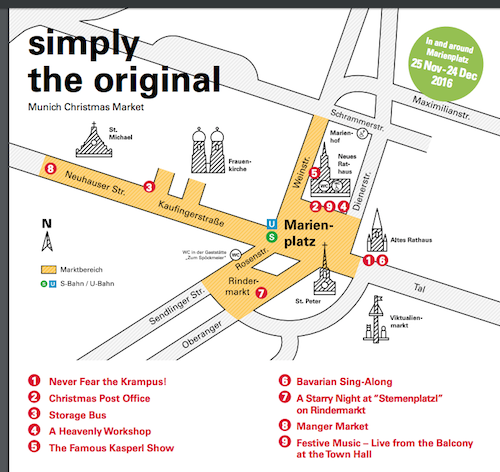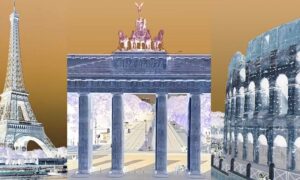I was lucky enough to live in Germany as a child where I had the opportunity to visit two of the most renowned Christmas markets (or Christkindlmärkte) in the world.
If you have children yourself, a trip to the nearest Christkindlmarkt is a must! Even if you don’t live in a big city or can’t get to one of the “original” markets, the lights and pageantry of any one of them will be an experience they (and you) will never forget.
I know I never did.

Nuremberg
More than two million visitors come to Nuremberg’s open-air market every year to drink the Glühwein, inhale the sweet scent of candied almonds, and eat Lebkuchen. Stalls are set up in the town square and staffed by vendors who hawk German goodies, hand-crafted Christmas ornaments, and last-minute gifts.
The festivities begin when Advent does, four weeks before Christmas.
Consumerism may drive tourists to the markets, but make no mistake about it: the Germans (especially in Catholic-centric Bavaria) take the markets’ historic ties to religion seriously.
In Nuremberg, for example, the market opens with the welcoming words of a local boy or girl portraying the Christkind (Christ child):
You men and women, who once yourselves were children,
Be them again today, happy as children be,
And now the Christkind to its market calls,
And all who come are truly welcome.
Nuremberg’s market has a separate area for children where they can take a spin on the merry-go-round or Ferris wheel and ride a kid-sized train. Booths where children can participate in hands-on activities such as writing a letter to Santa, making candles, and decorating cookies can all be found in the Children’s Christmas Market.
Also adjoining the Christkindlesmarkt is the Market of the Sister Cities, where craftsmen sell international wares from all of Nuremberg’s sister cities.
Tired of walking? Visitors can tour the market in a horse-drawn stagecoach, or board a tram/train at Hallplatz for a tour of the medieval buildings that surround the town square.
MUNICH
Munich’s Christkindlmarkt starts in front of the town’s world-famous Glockenspiel and is spread across 20,000 square meters of the pedestrian zone.
By the time we lived in Munich, I was old enough to drink the Glühwein with brandy added and I had developed a craving for Gebrannte Mandeln, almonds coated in crunchy, browned sugar. To this day, the smell of these Christmas market favorites takes me back in time.
If you’re really into German food and wine (and really, who wouldn’t be?) a culinary group offers a tasting tour of the market during which you can try Stollen, Rahmschmankerl, and other seasonal culinary favorites.
Be sure to visit the Sternenplatzl (Square of Stars) at Rindermarkt and the massive Christmas tree that stands in Marienplatz to see Christmas lights like you’ve never seen them before. Last year’s tree weighed 5.3 tons and was illuminated with 3,000 lights!
As with Nuremberg’s market, smaller auxiliary markets are held nearby, including the Medieval Christmas Market, where visitors can see minstrels, knights, and noblewomen celebrating the way they did in the Middle Ages when Munich’s first Christmas market was held.
At the Kripperlmarkt, tourists and locals can buy hand-carved wooden pieces for their crèche collection. A popular walking tour of the Christkindlmarkt and the Manger Market is led by guides who tell visitors about the history and culture of the markets.
For the convenience of those who have bought more Christmas goodies than they can carry, Munich’s public transportation association provides the Packerlbus, where shoppers can stash their packages on Saturdays during Advent.
The details:
• The Nuremberg Christmas Market is one of the oldest (1600s) and largest in Europe. In fact, it sets the standard for the rest, with strict rules on curated goods on display; ie, no plastic toys and cheap tchotkes (if we may use a Yiddish word to describe a Christmas market). The market stresses local craftsmanship and quality for the ornaments and other goods. Even the children in the pageants are carefully selected and vetted.
The Nuremberg Christmas Market is open 1 December through 24 December. The market launches with an official ceremony at 17:30 on 1 December, the Friday before the first Sunday of Advent – with trumpets blowing and children singing.
The market is open every day from 10:00 to 21:00 except Christmas Eve, when it closes at 14:00.
Nuremburg is in south-central Germany, about 170 kilometers north of Munich. The market is in the center of the Old City. You can’t miss it.
• The Munich Christmas Market claims to be even older than Nuremberg, so there’s a bit of a rivalry between these Germany cities as to who has the oldest and best Christmas Market. Munich’s dates back to the Nicholas markets held in the 14th century. The first reference in town records relates to a market known as the Nikolaidult held on Kaufingerstrasse near the Schönen Turm tower in 1642.
Munich certainly has claim to the biggest Tannenbaum, with a tree 30-meters (300 feet) tall with 2,500 candles.
The market is open from 24 November through Christmas Eve for 2017.

BETH
Opening hours are:
Mon-Sat 10 am to 9 pm
Sun 10 am to 8 pm
Christmas Eve, 10 am to 2 pm
About the author: Beth Hoke is rejoining the expat life after spending her childhood in Europe and the United States, then settling in Chicagoland to raise two daughters.
Now an empty nester, she is roaming Europe, armed with a TEFL certificate and an online position teaching English for EF.
Beth has been traveling around Europe for nine months. She’s filed posts from six countries including Italy, Germany, Croatia, and Madeira, Portugal.















